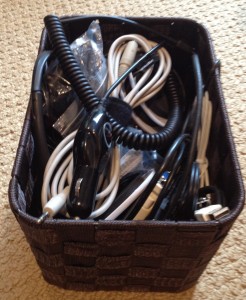 They say a clean desk is the sign of a sick mind. At least I’d like to believe that’s true, considering the sorry state of mine. And while I can usually find what I’m looking for in the chaos of clutter (I have a system, really!), my system works off a combination of habit and vague recall. I know it would be difficult, if not impossible, for anyone else to make sense of my mess.
They say a clean desk is the sign of a sick mind. At least I’d like to believe that’s true, considering the sorry state of mine. And while I can usually find what I’m looking for in the chaos of clutter (I have a system, really!), my system works off a combination of habit and vague recall. I know it would be difficult, if not impossible, for anyone else to make sense of my mess.
I’ve often thought of getting an organizer to come in and help me, but I start to think about everything I would have to clean up before he or she showed up. IT organizations are all too often like my cluttered desk, and this comes to light when they look into outsourcing or managed services. Habit and vague recall are not easily transferrable.
Cleaning Before The Cleaning People
There are some people who clean up before the cleaning people show up to their house, so they don’t waste time tidying up the clutter and get to what really needs to be cleaned. There is an element of truth when this is applied to getting started with a managed service provider (MSP). We already know the weakest point in most IT organizations is documentation, so the less your new MSP has to figure out on their own, the faster (and cheaper!) it will be to get started.
One of the unexpected costs of entering into an MSP relationship is coming to terms with your clutter. Just like when you get married and your financial debt can be an issue for your spouse, so it’s true with your MSP and your technical debt — the systems you’ve been carrying on life support or patched with duck tape and bubble gum to keep in service. They fall into 2 basic categories:
- old hardware and software you’ve avoided upgrading or replacing because it still works and “if it ain’t broke, don’t fix it” or just haven’t gotten around to replacing it;
- custom and orphan systems (software no longer supported by vendor).
I’m talking about that payroll application that is still running on Windows 2003 Server and you no longer have the original software to reinstall it somewhere else. Or the document scanning software you purchased 10 years ago from a vendor that’s since gone out of business. These systems are critical to your business but they are difficult and costly to maintain.
This Is How We’ve Always Done It
To address these challenges, we need to keep in mind the core competitive value proposition for MSP’s lies in standardization to drive economies of scale. Exceptions are the bane of their existence. This means there will most likely be a gap between how you are currently doing things and how your MSP wants you to do things. It’s a culture clash, of sorts. I remember doing an implementation of an new ERP system for the United Nations many years ago. While there were many technical challenges to overcome, the biggest challenge was cultural. The new ERP system required the end users to change the way they did things. The bottom line is, for the things you’re hiring them to manage, you will need to change the way you operate to match how they need to deliver their services.
This is not bad thing.
No Pain, No Gain?
Remember there was a reason you decided to outsource in the first place. It’s not your core business. Yes, there will be some effort on your part to clean up your clutter and yes, you will change how you operate to align with the requirements and best practices of your new partner aka your MSP. Bottom line? Be prepared for a little cultural adjustment for you to truly reap the benefits of the new relationship.
__
This post was brought to you by IBM for MSPs and opinions are my own. To read more on this topic, visit IBM’s PivotPoint. Dedicated to providing valuable insight from industry thought leaders, PivotPoint offers expertise to help you develop, differentiate and scale your business.